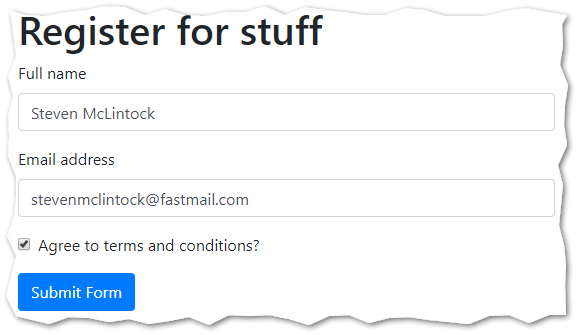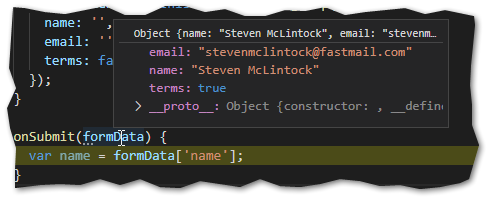Using Angular 8 to Create a Simple Form with FormBuilder
By Steven McLintock onIf you’ve chosen to use Angular to build the UI for your web application, or find yourself using it in an existing project, the chances are high that you’re going to create a form at some point. When I was searching for how to build one myself, I found there were several contradicting examples for different versions of Angular.
This example is for Angular 8 and essentially borrows heavily from the official Google documentation. There is one “gotcha” that wasn’t included in the documentation that stumped me along the way, so hopefully this helps someone building their first Angular form.
app.component.html
The HTML is fairly simple. I’m using some Bootstrap classes to help with the layout, but it’s basically a regular HTML form with some Angular attribute directives on the form and input elements. Once the user is ready to submit the form, the onSubmit() method is executed with the form data.
<div class="container">
<h1>
{{title}}
</h1>
<form [formGroup]="formGroup" (ngSubmit)="onSubmit(formGroup.value)">
<div class="form-group">
<label for="name">Full name</label>
<input type="text" class="form-control" id="name"
placeholder="Enter full name" formControlName="name" />
</div>
<div class="form-group">
<label for="name">Email address</label>
<input type="email" class="form-control" id="email"
placeholder="Enter email" formControlName="email" />
</div>
<div class="form-group form-check">
<input type="checkbox" class="form-check-input"
id="terms" formControlName="terms" />
<label class="form-check-label" for="terms">Agree to terms and conditions?</label>
</div>
<button class="btn btn-primary" type="submit">Submit Form</button>
</form>
</div>
app.component.ts
In the typescript component, we’re importing the FormBuilder library and including it in the constructor of the component to be able to initiate the form. There is also the onSubmit() method that you could use to send the data in a POST or PUT request to an API. In this example we’ll just assign one of the fields to a variable for debugging purposes.
import { Component } from '@angular/core';
import { FormBuilder } from '@angular/forms';
@Component({
selector: 'app-root',
templateUrl: './app.component.html',
styleUrls: ['./app.component.css']
})
export class AppComponent {
title = 'Register for stuff';
formGroup;
constructor(
private formBuilder: FormBuilder
) {
this.formGroup = this.formBuilder.group({
name: '',
email: '',
terms: false
});
}
onSubmit(formData) {
var name = formData['name'];
}
}
app.module.ts
This is the “gotcha” that stumped me in the beginning. It is missing in the official documentation, but if you try and load the form in a web browser and receive the error message “Can’t bind to ‘formGroup’ since it isn’t a known property of ‘form’“, you need to include “ReactiveFormsModule” in your app module.

import { BrowserModule } from '@angular/platform-browser';
import { NgModule } from '@angular/core';
import { FormsModule, ReactiveFormsModule } from '@angular/forms';
import { HttpModule } from '@angular/http';
import { AppComponent } from './app.component';
@NgModule({
declarations: [
AppComponent
],
imports: [
BrowserModule,
FormsModule,
HttpModule,
ReactiveFormsModule
],
providers: [],
bootstrap: [AppComponent]
})
export class AppModule { }
Once you’ve created the HTML, typescript component and configured the app module, you should be ready to try it out!

If you set a breakpoint in the onSubmit() method, you should be able to see the form data being passed in.

